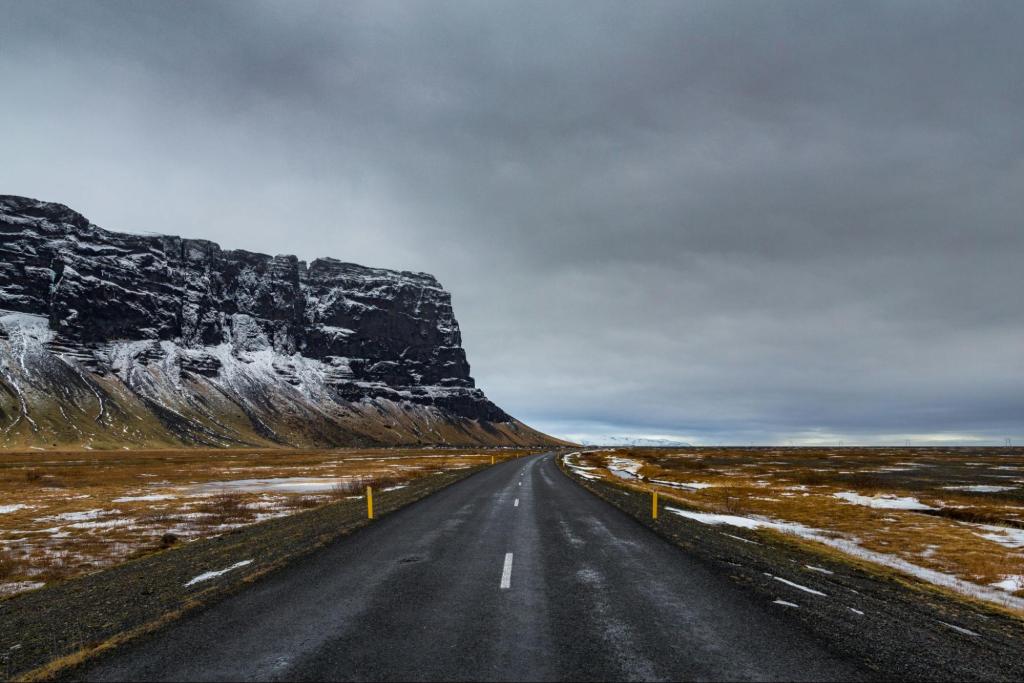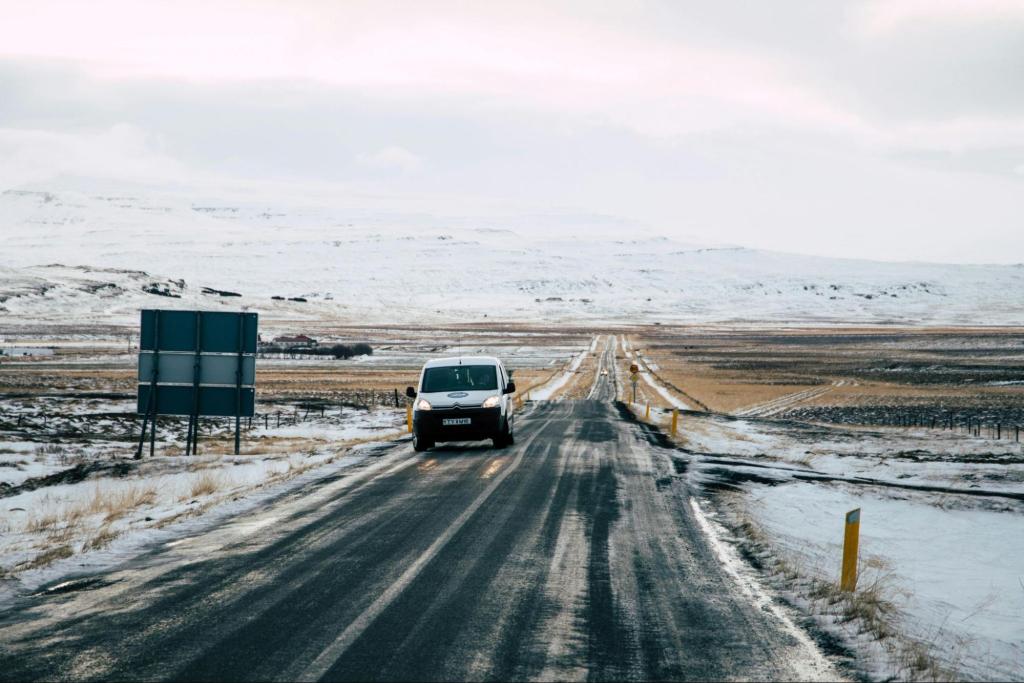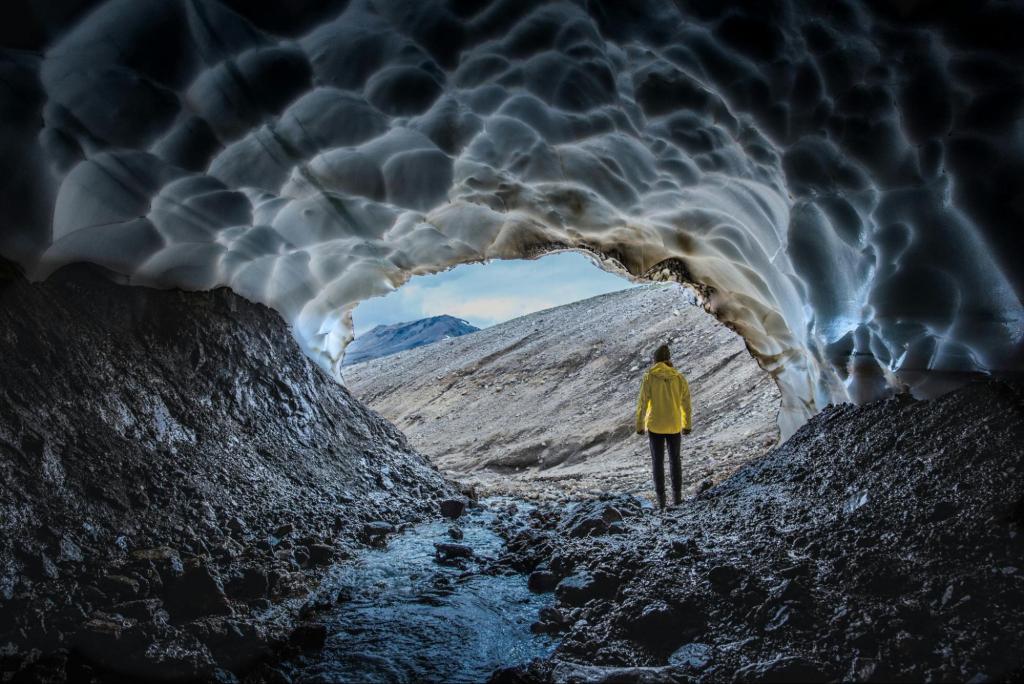


Get to know Iceland
Iceland in December is a winter travel period shaped by limited daylight hours, snow-covered landscapes, sub-zero temperatures, and infrastructure adapted for winter conditions.
Campervan travel in December offers a flexible and immersive experience. With self-paced routing and access to regulated campsites, travelers can adapt their routes to changing weather and daylight conditions, and enjoy direct access to unique winter attractions, including hot springs, ice caves, and aurora-filled skies.
Insulated interiors, efficient heating systems, and winter tires are essential components of a campervan equipped for cold climates. Well-maintained roads further support safe and stable winter travel.
Iceland in December presents weather conditions that directly affect how campervan trips are planned. Cold temperatures, limited daylight, frequent snowfall, and Atlantic winds shape campervan travel conditions.
Average temperatures typically range from -1°C to 4°C (30–39°F), with colder zones inland and at higher elevations. Due to limited daylight, which is just 4 to 5 hours per day, there’s insufficient sunlight to warm surfaces, especially in shaded or elevated areas. As a result, temperatures remain low for extended periods, allowing frost to accumulate overnight and persist into the morning, significantly impacting road traction.
Snow is frequent, especially in the north and higher elevations, and can accumulate quickly, affecting which roads are safe to use.
Wind patterns, driven by shifting Atlantic pressure systems, often produce gusts exceeding 50 km/h (31 mph), occasionally reaching 80 km/h (50 mph) in exposed regions, which impacts the stability of high-roof campervans and increases the effect of wind chill.
In December, Iceland’s average temperatures range between -1°C and 4°C (30–39°F), requiring campervan travelers to prepare for subfreezing nights and barely-above-zero days with effective interior heating, vehicle insulation, and layered cold-weather clothing. While southern coastal areas, such as Reykjavik, are slightly milder, northern and inland regions often register several degrees lower, increasing the exposure to freezing temperatures during early departures or overnight stays.
These thermal conditions also increase the likelihood of snowfall and icy roads, underscoring the importance of winter-adapted equipment and cautious route planning. However, wind chill may intensify the perceived cold; it does not materially alter heating or driving preparations.
In December, Iceland averages 4 to 5 hours of daylight, with sunrise and sunset shifting slightly throughout the month before stabilizing near the solstice. Beyond these hours, polar twilight provides soft, ambient light that extends visibility.
For campervan travelers, this limited daylight requires early starts and tightly planned routes, as most attractions depend on natural light for access and experience. While daytime travel is compressed, longer nights increase the chances of Northern Lights visibility.
Snowfall is frequent across Iceland in December, with lighter, intermittent accumulation along the coasts and deeper, more consistent coverage in northern and inland high-altitude regions, typically ranging from 5 to 20 cm (2 to 8 inches) per event.
Roads, especially the Ring Road, are cleared regularly and remain accessible under most conditions; however, some highland and secondary routes may close during periods of heavier snow. Campervan travel remains feasible with mandatory snow tires and proper preparation for varying traction and route accessibility.
Iceland in December often experiences strong winds, particularly along coastal areas and mountain passes, with speeds ranging from 40 to 80 km/h (25 to 50 mph) and higher gusts during Atlantic-driven storms that occur several times a month.
These conditions often result in temporary road closures, travel advisories, and reduced visibility, particularly in northern and elevated regions. While modern campervans offer good stability, travelers must remain cautious on exposed routes and consult daily wind alerts from the Icelandic Met Office to adjust plans proactively and avoid disruptions.

In December, road conditions in Iceland vary by region and weather. Yet, the Ring Road generally remains accessible and well-maintained, supporting island-wide travel and reaching key destinations even during winter. However, interior and highland routes are closed due to snow or ice, limiting access beyond the primary network.
The Icelandic Road and Coastal Administration monitors these conditions, providing real-time alerts that help travelers, especially campervan users, adjust plans as needed. In Iceland in winter, road crews actively clear snow, treat icy surfaces, and adjust access based on shifting weather conditions, keeping main routes open whenever possible.
However, storms, rapid changes, and reduced daylight hours require drivers to remain flexible and prepared. For campervan travel, this means that daily updates are essential, adaptable routes are necessary, and safety-first planning is crucial.
Iceland’s Ring Road (Route 1) remains open and well-maintained throughout December, serving as the primary route for campervan travel, while inland and secondary roads, particularly F-roads crossing the highlands, are closed due to snow, ice, and safety restrictions, rendering them inaccessible.
Real-time road conditions are provided by the Icelandic Road and Coastal Administration (vegagerdin.is), allowing travelers to monitor updates and adapt their routes accordingly.
Despite seasonal closures, key regions such as the south coast, Snæfellsnes Peninsula, and the Golden Circle remain accessible by campervan thanks to consistent winter maintenance, with alternative routes typically available and announced in advance, enabling reliable and flexible planning.
Driving a campervan in Iceland during December requires adherence to winter protocols, which begin with the legally required studded or winter tires included on all rentals. Rapid weather shifts, particularly in exposed or elevated regions, often reduce traction and visibility, requiring travelers to monitor updates from the Icelandic Met Office and Vegagerðin for real-time road and weather data.
Essential precautions include operating at slower speeds, maintaining longer braking distances, using continuous headlight operation, and avoiding abrupt inputs, while keeping fuel levels high in remote areas with limited access.
Equipped with insulation, heating, and mechanical support, winter-ready campervans sustain comfort and control, ensuring safe travel when paired with vigilance and flexibility.

Campervan travel in Iceland during December remains fully supported, with insulated, heated rentals equipped for snow and paired with actively maintained roads, ensuring comfort and mobility despite winter conditions.
Unlike fixed accommodations, campervans allow spontaneous routing, real-time weather adaptation, and aurora chasing without the constraints of hotel check-ins, making them ideal for navigating limited daylight hours with early starts or mid-day stops.
Designed for off-season independence, modern campervans provide the support needed for overnight stays in remote areas through onboard heating and power systems, enabling immersive access to scenic routes like the South Coast and the Snæfellsnes Peninsula.
As part of proper campervan Iceland winter travel preparation, this autonomy requires the right equipment setup, legal campground access, and dependable power management.
Campervans used in the Icelandic winter must be equipped for winter conditions, including cold temperatures, ice on roads, and autonomous use. Legally required winter tires with studs ensure traction, while full insulation across walls, floors, and windows retains heat.
Diesel or electric heaters are essential and rely on internal batteries or portable power units that support heating, lighting, and charging, even in the absence of campsite access. USB, 12V, and shore power converters enable off-grid energy use.
Propane or electric stoves must be properly ventilated and paired with carbon monoxide detectors. Additionally, water tanks require frost protection by being kept inside the heated cabin. Snow brushes, ice scrapers, and thermal curtains support visibility, safety, and warmth. Most rentals are winter-ready, but all equipment must be confirmed before booking.
In Iceland, overnight campervan parking is strictly limited to designated campsites, with wild camping, including roadside pullouts, private land, or informal stops, prohibited year-round, including December, and enforced even in remote areas.
Although many campsites close for the winter, several remain open in accessible regions, such as the South Coast, Golden Circle, and parts of West Iceland. These campsites, commonly featured in any reliable Iceland campsites guide, typically offer essentials like electric hookups, heated restrooms, and minimal maintenance access, although snow or wind may restrict site accessibility. Travelers should use resources like tjalda.is to confirm campsite openings, facility access, and any winter-specific restrictions due to snow or wind.
The Camping Card network, or apps like Park4Night, can be used to confirm campsite availability, plan overnight stops accordingly, and ensure compliance with parking regulations.
Given limited daylight and freezing conditions, route planning must be coordinated with operational campsites, as overnight stays at gas stations or non-designated spots are unlawful unless explicitly permitted.
To stay compliant and avoid illegal stops, route planning should align with verified campsite availability; resources labeled under the Iceland campsites guide offer essential coverage for legal overnight parking during the holiday.
Icelandic winter campervans utilize dual-battery systems to power lighting, charging ports, fridges, and heating ignition, providing basic autonomy but necessitating recharging every 24-48 hours due to limited daylight and high energy demands.
Power is replenished via an alternator while driving or through widely available campsite hookups; most rentals include necessary cables. Diesel heaters draw fuel but need battery ignition, making energy failure a direct threat to warmth and function. Solar panels are ineffective in December, and portable backups support only small devices. Without planned charging, power loss means losing heat, light, and mobility.

The Golden Circle remains Iceland’s most campervan-accessible winter route, with its 230 km paved loop maintained for safe driving in December. Þingvellir, Geysir, and Gullfoss offer dramatic contrasts, including snow-covered rifts, steaming geysers, and frozen falls, all reachable within a daylight-efficient circuit if started early.
Parking is open but may require slow maneuvering on ice, making winter tires and cautious speeds essential. Campervans provide heat, meals, and shelter between stops, reducing reliance on limited services and supporting flexible travel pacing. If conditions permit, Kerið or the Secret Lagoon can extend the loop without exceeding daylight constraints.
Iceland’s South Coast remains reliably accessible in December, with the Ring Road plowed and paved, allowing for safe campervan travel, even in windy conditions. Major stops, such as Seljalandsfoss (front viewing only), Skógafoss (partially frozen), and Reynisfjara (safety caution required), lie directly along the route, offering clear access and parking.
Vík anchors the midpoint for fuel and supplies, while Jökulsárlón and Diamond Beach, located further east, remain accessible, offering winter contrasts of ice and black sand. The route follows a linear structure with minimal detours, and open campgrounds in Vík and Skaftafell provide overnight parking with electricity.
Strong winds near Vík may require slower speeds, and the short daylight hours favor splitting the trip into one or two days with early starts and planned stops. Low light pollution also positions this corridor well for viewing the aurora.
West Iceland and the Snæfellsnes Peninsula are accessible with caution by campervan in December, with Routes 54 and 574 generally maintained but prone to icy or wind-exposed sections, especially near Snæfellsjökull National Park, where spur roads leading to the glacier may close due to snow or gusts.
Despite harsher weather than the southern coast, key sites like Kirkjufell, Kirkjufellsfoss, Búðir’s black church, and the coastal paths at Arnarstapi and Hellnar remain reachable via paved roads.
However, trail and surface conditions should be confirmed in advance. Campervan travel is supported by parking near attractions and limited winter campsites in Grundarfjörður and Stykkishólmur, with reduced services requiring flexible planning. The loop is best approached as a two-day trip from Reykjavik, adapting to daylight and storm tracking, while the region’s low light pollution enhances northern lights visibility when skies are clear.

December is prime time for seeing the Northern Lights in Iceland. The long nights, up to 20 hours of darkness, create one of the best visibility windows of the year.
Auroras are visible when skies are clear and light pollution is low. That means rural areas, far from towns, offer the best viewing. Solar activity stays fairly consistent in winter, but cloud cover is the main obstacle. Even strong auroras can’t be seen through overcast skies.
Campervan travel enables real-time relocation toward better conditions. Unlike fixed accommodations, mobile travel allows for continuous adjustment based on live aurora forecasts and cloud maps, such as those provided by the Icelandic Met Office.
Regular monitoring of these tools during evening hours increases the likelihood of clear-sky positioning. This observational flexibility makes campervans particularly effective for viewing the aurora in December.
In December, the best places to see the Northern Lights in Iceland offer three key elements: dark skies, clear weather, and easy road access.
The South Coast near Vík offers open, dark areas right off the Ring Road—easy to access, ideal for parking.
The Snæfellsnes Peninsula offers a unique blend of low light pollution, well-maintained roads, and strategically placed viewpoints.
Thingvellir National Park remains accessible despite being close to Reykjavík, allowing for quick repositioning if conditions change.
The outskirts of Akureyri in the north often offer clearer skies and remain accessible on winter roads.
The Westfjords offer some of the darkest skies, but they are remote and weather-sensitive, which is ideal for prepared, experienced drivers.
Reykjavík is too bright for reliable viewing unless the aurora is unusually strong.
Campervans let travelers follow forecasts and relocate quickly. That mobility turns conditions into opportunities.
Aurora visibility in Iceland during December depends on clear or mostly clear skies, with cloud cover acting as the primary inhibitor; even thin layers reduce contrast and obstruct observation. Fog, low coastal clouds, and inversion layers, common in the South Coast, further limit sky clarity, while inland elevations offer better conditions.
Wind patterns modulate these effects by either dispersing or trapping cloud banks, making sky access highly variable. Real-time forecasts from the Icelandic Met Office enable travelers to track cloud movement and predict clear zones.
For campervan users, this data becomes actionable, as mobility allows for dynamic repositioning, converting forecast insights into a tactical visibility advantage.

Ice caving in Iceland is a winter-only activity, available from mid-November to March, with December firmly within its peak window. However, access is strictly limited to licensed guided tours due to safety risks and the unstable nature of glacier caves.
Most tours operate in the Vatnajökull region, primarily from Skaftafell or Jökulsárlón, both situated along the South Coast and easily reachable via the Ring Road, which aligns well with typical campervan routes and offers nearby campsites for early departures or overnight positioning.
Because tours are weather-dependent and subject to sudden cancellations, itineraries should remain flexible. Campervan travel supports this adaptability by allowing repositioning between campsites and maintaining access to shifting tour schedules.
Lava caving in Iceland, a guided tour through volcanic tunnels, remains accessible in December due to stable underground conditions unaffected by snow or ice.
With self-exploration prohibited, key sites like Raufarhólshellir, near Reykjavik, and Vatnshellir in Snæfellsnes align perfectly with the Golden Circle and westbound campervan routes, which are accessible via winter roads and included in many seasonal tour packages.
Consistent temperatures make it a reliable option when weather cancels glacier hikes or aurora viewing, offering flexible, weatherproof scheduling during limited daylight.
Glacier tours operate in December as fully guided experiences, typically involving hikes, snowmobiling, or combinations of both, including glacier–ice cave excursions. Based near Vatnajökull and Mýrdalsjökull along the South Coast, they integrate seamlessly into campervan routes without requiring detours.
Essential gear is provided by operators, while wind and storm risks may prompt cancellations; travelers should leave a buffer and avoid rigid schedules. Overnighting near base camps supports early starts, improving participation odds and making efficient use of short daylight hours.
Hot springs are accessible year-round, and they are especially valued in December for the contrast between the cold air and the warm water. While natural springs like Reykjadalur and Hrunalaug may require hazardous winter hikes, developed pools, such as Blue Lagoon, Sky Lagoon, Secret Lagoon, and Myvatn Baths, offer road access, extended hours, and key amenities.
Aligned with major campervan routes across the South Coast, Golden Circle, and Northern Iceland, hot springs in Iceland offer parking, facilities, and secure entry, making them ideal for evening stops or backups when weather disrupts outdoor plans.
Whale watching tours operate in December, but only reliably from Reykjavik harbor, as northern hubs like Húsavík and Akureyri largely suspend operations for the season, making the capital the default choice, especially for campervan travelers based nearby.
Sightings typically include minke whales, white-beaked dolphins, and occasional orcas, though both variety and frequency are reduced compared to summer. Tours depend on sea conditions, with cancellations common during rough weather, so flexible planning is essential.
Reykjavik’s harbor offers accessible parking and proximity to major routes, making it a convenient stop for early or late campervan itineraries.

From December 24th to 26th, Iceland’s national Christmas observance results in widespread closures of fuel stations, grocery stores, restaurants, and campsites, particularly in rural areas where alternatives are limited, making early preparation for supplies and parking essential.
Travelers should not expect regular hours or spontaneous stops, as most services shut down or reduce access; popular campsites are often full, and legal parking options are scarce. While Reykjavik offers festive lighting and public displays that add visual interest during downtime, this period functions as a logistical freeze requiring route flexibility and full self-sufficiency.
New Year’s Eve on December 31st is marked by widespread resident-driven fireworks in Reykjavik and other urban areas, beginning late afternoon and continuing past midnight, generating persistent noise that disrupts overnight rest. Resulting congestion and limited parking require campervan travelers to secure spots early and avoid residential zones.
Road access narrows sharply by evening, and public transit slows, making early positioning essential. Most shops and fuel stations close early on December 31st and operate minimally on January 1st, so refueling, restocking, and routing should be completed in advance to prevent disruption.

CampEasy Opening hours 09:00-16:00
Learn more about Self-Service
A minimum of 20 hours notice is required to use the booking engine. Click here to contact us directly for a booking less than 20 hours from now.
Change Date